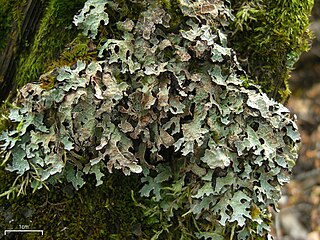
Parmelia is a genus of medium to large foliose (leafy) lichens. It has a global distribution, extending from the Arctic to the Antarctic continent but concentrated in temperate regions. There are about 40 species in Parmelia. In recent decades, the once large genus Parmelia has been divided into a number of smaller genera according to thallus morphology and phylogenetic relatedness.

Myelochroa is a genus of foliose lichens in the family Parmeliaceae. They are commonly known as axil-bristle lichens. It was created in 1987 to contain species formerly placed in genus Parmelina that had a yellow-orange medulla due to the presence of secalonic acids. Characteristics of the genus include tightly attached thalli with narrow lobes, cilia on the axils, and a rhizinate black lower surface. Chemical characteristics are the production of zeorin and related triterpenoids in the medulla. Myelochroa contains about 30 species, most of which grow on bark. The genus has centres of distribution in Asia and North America.

Melanohalea is a genus of foliose lichens in the family Parmeliaceae. It contains 30 mostly Northern Hemisphere species that grow on bark or on wood. The genus is characterised by the presence of pseudocyphellae, usually on warts or on the tips of isidia, a non-pored epicortex and a medulla containing depsidones or lacking secondary metabolites. Melanohalea was circumscribed in 2004 as a segregate of the morphologically similar genus Melanelia, which was created in 1978 for certain brown Parmelia species. The methods used to estimate the evolutionary history of Melanohalea suggest that its diversification primarily occurred during the Miocene and Pliocene epochs.

Cetrelia is a genus of leafy lichens in the large family Parmeliaceae. They are commonly known as sea-storm lichens, alluding to the wavy appearance of their lobes. The name of the genus, circumscribed in 1968 by the husband and wife lichenologists William and Chicita Culberson, alludes to the former placement of these species in the genera Cetraria and Parmelia.

Dalip Kumar Upreti is an Indian lichenologist. He served as Director and Chief Scientist at CSIR-National Botanical Research Institute, Lucknow during 1988 to 2017. Also he served as Head of Lichenology and herbarium division. Presently he is serving as CSIR-Emeritus Scientist in the same division.
Hypotrachyna lueckingii is a species of corticolous (bark-dwelling), foliose lichen in the family Parmeliaceae. It is only known to occur at high elevations on the Cordillera de Talamanca in Costa Rica.
Parmotrema abessinicum is a species of corticolous lichen in the family Parmeliaceae. It has been recorded from Africa, Asia, and Oceania.

Punctelia bolliana, the eastern speckled shield lichen, is a species of foliose lichen in the family Parmeliaceae. It is found in North America, with a distribution extending from the Canadian province of Ontario south to the central and northeastern United States and Mexico. It grows on the bark of both deciduous trees and coniferous trees. The combination of characteristics that distinguishes this species from others in genus Punctelia are the absence of the vegetative propagules isidia and soralia, a pale brown lower thallus surface, and the presence of the secondary chemical protolichesterinic acid in the medulla.
Parmelia ambra is a fossilised species of foliose lichen in the family Parmeliaceae. Found in Dominican amber and described as a new species in 2000, the fossil has been used in subsequent studies of lichen evolution.
Parmelia hygrophiloides is a species of foliose lichen in the family Parmeliaceae. Found in India, it was described as a new species in 2003 by lichenologists Pradeep Divakar, Dalip Kumar Upreti, and John Elix. The type specimen was collected in the Parbati River Valley in Himachal Pradesh, at an elevation of 2,400 m (7,900 ft); here it was found growing on the trunk of a pine tree.

Parmelia barrenoae is a species of foliose lichen in the large family Parmeliaceae. It was formally described as a new species in 2005. Before this, it was lumped together as one of several lichens in the Parmelia sulcata group—a species complex of genetically distinct lookalikes. Parmelia barrenoae is widely distributed, occurring in Europe, western North America, Africa, and Asia.
Ocellularia upretii is a species of corticolous (bark-dwelling) lichen in the family Graphidaceae. It is found in India.
Parmotrema lawreyi is a species of corticolous (bark-dwelling), foliose lichen in the family Parmeliaceae. Found on the Galápagos Islands, it was formally described as a new species in 2019 by lichenologists Frank Bungartz and Adriano Spielmann. The type specimen was collected by the first author from the foothills of Media Luna on San Cristóbal Island, where it was found in dry, open woodland growing on the trunk of Bursera graveolens. The species epithet honours the authors' colleague James D. Lawrey, "on the occasion of his 70th birthday".
Parmotrema cactacearum is a rare species of corticolous (bark-dwelling), foliose lichen in the family Parmeliaceae. Found on the Galápagos Islands, it was formally described as a new species in 2019 by lichenologists Frank Bungartz and Adriano Spielmann. The type specimen was collected from Pinta Island at an altitude of 289 m (948 ft), where it was found growing on an old cactus pad in an open woodland. It is only known from the type specimen. The species epithet refers to its substrate.
Parmotrema erectociliatum is a rare species of saxicolous (rock-dwelling), foliose lichen in the family Parmeliaceae. Found on the Galápagos Islands, it was formally described as a new species in 2019 by lichenologists Frank Bungartz and Adriano Spielmann. The type specimen was collected from Santa Cruz Island near Academy Bay, where it was found growing on a boulder on a talus slope under a ravine. It is only known from the type specimen. The species epithet refers to its long, erect cilia.
Parmotrema marcellianum is a species of saxicolous (rock-dwelling), foliose lichen in the family Parmeliaceae. Found on the Galápagos Islands, it was formally described as a new species in 2019 by lichenologists Frank Bungartz and Adriano Spielmann. The type specimen was collected from Cerro Ventanas on Floreana Island at an altitude of 424 m (1,391 ft); there, it was found overgrowing pebbles on sun-, wind-, and rain-exposed ground. The species epithet honours the authors' colleague Marcelo Pinto Marcelli, "in recognition of his work on the lichen family Parmeliaceae".
Parmotrema pustulotinctum is a rare species of foliose lichen in the family Parmeliaceae. Found on the Galápagos Islands, it was formally described s a new species in 2019 by lichenologists Frank Bungartz and Adriano Spielmann. The type specimen was collected from Santiago Island at an altitude of 362 m (1,188 ft), where it was found growing on an exposed vertical boulder. It is only known from the type collection. The species epithet refers to its isidia, that are pustulate and readily distinguishable from those of the closely related P. tinctorum.
Parmotrema saxoisidiatum is a rare species of saxicolous (rock-dwelling), foliose lichen in the family Parmeliaceae. Found on the Galápagos Islands, it was formally described as a new species in 2019 by lichenologists Frank Bungartz and Adriano Spielmann. The type specimen was collected from Floreana Island at an altitude of 365 m (1,198 ft), where it was found growing on a lava cliff. It is only known from the type specimen. The species epithet refers to both its substrate and its idisia, which are simple, cylindrical, and mostly unbranched.
Melanelia microglabra is a rare species of saxicolous (rock-dwelling) foliose lichen in the family Parmeliaceae. It is found in high-elevation locations in Sikkim, India.
Caloplaca himalayana is a species of lignicolous (wood-dwelling) crustose lichen belonging to the family Teloschistaceae. Found in the Himalayas of India, it was described as new to science in 2009. The lichen has a yellowish thallus with rusty red apothecial discs.






